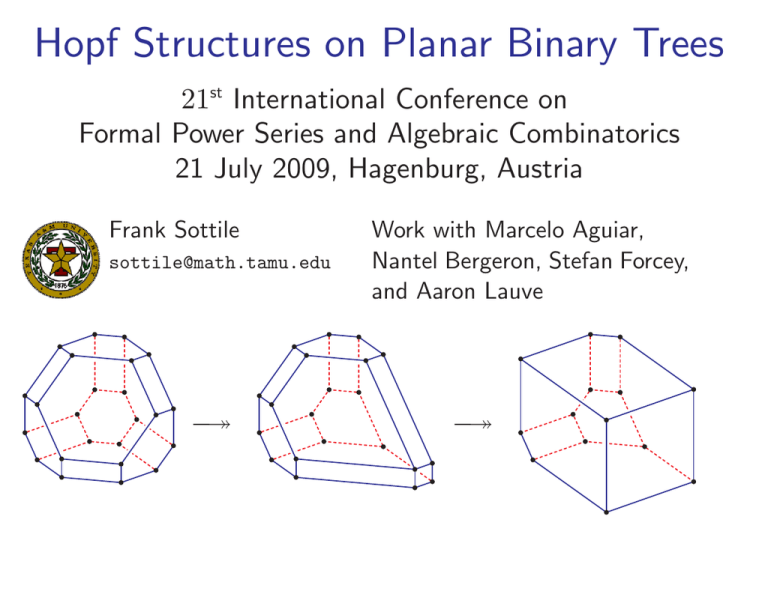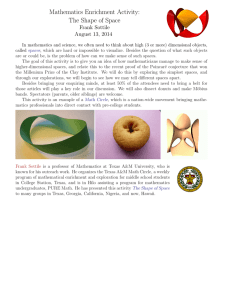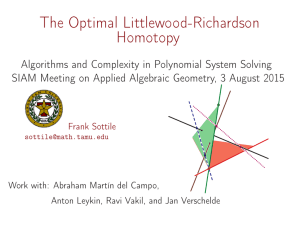Hopf Structures on Planar Binary Trees
advertisement

Hopf Structures on Planar Binary Trees
21st International Conference on
Formal Power Series and Algebraic Combinatorics
21 July 2009, Hagenburg, Austria
Frank Sottile
sottile@math.tamu.edu
−։
Work with Marcelo Aguiar,
Nantel Bergeron, Stefan Forcey,
and Aaron Lauve
−։
Hopf algebras in combinatorics
A Hopf algebra H is an algebra whose linear dual is also an algebra,
with some compatibility between the two structures.
This means that H has a coassociative coproduct,
∆ : H → H ⊗ H , which is an algebra homomorphism.
Joni and Rota (‘79): coproducts are natural in combinatorics;
they encode the disassembly of combinatorial objects.
Today, I’ll discuss some old and new Hopf structures based on trees.
See also the poster by Aaron Lauve.
Frank Sottile, Texas A&M University
1
(Hopf) algebra of symmetric functions
Sym := Q[h1, h2, . . . ] is the (Hopf) algebra of
symmetric functions. (Newton, Jacobi (1841))
– Graded with bases indexed by partitions.
– Hopf structures described combinatorially.
– Self-dual.
– ∆hk =
X
hi ⊗ hj .
i+j=k
→ Perhaps the most fundamental object in
algebraic combinatorics.
Frank Sottile, Texas A&M University
Sym
2
Quasi-symmetric functions
QSym : Quasi-symmetric functions. (Gessel ‘83)
– Introduced for combinatorial enumeration.
– Aguiar-Bergeron-S.: Universal target for
combinatorial generating functions.
– Bases Fα, Mα for α a composition.
∆M(a1,...,ap) =
p
X
M(a1,...,ai)⊗M(ai+1,...,ap)
i=0
QSym
¡
¡
µ
¡
¡
Sym
⇒ Primitives are {M(n) | n > 0} and QSym is cofree.
Frank Sottile, Texas A&M University
3
Non-commutative symmetric functions
NSym := Qhh1, h2, . . . i. (Gel’fand, Krob,
Lascoux, Leclerc, Retakh, Thibon ‘95)
(also Malvenuto-Reutenauer ‘95)
– Related to Solomon’s descent algebra.
– Graded dual to QSym,
(product and coproduct are dual).
X
∆hk =
hi ⊗ hj .
i+j=k
Frank Sottile, Texas A&M University
NSym
@
@
QSym
@
R
@
¡
¡
µ
¡
¡
Sym
4
Malvenuto-Reutenauer Hopf algebra
SSym : Malvenuto-Reutenauer Hopf algebra
of permutations (‘95).
SSym
– Self-dual Hopf algebra.
– Basis {Fw | w ∈ Sn, n ≥ 0} indexed by
permutations.
£
£
£
£
£
£
£
£
B
£±£
B
B
NSym
permutations = ordered trees
Ordered tree : linear extension of node poset of
a planar binary tree. (w ∈ Sn has n nodes.)
@
@
B
B
B
B
B
BNB
QSym
@
R
@
¡
¡
µ
¡
¡
Sym
3 2 75 1 6 4
3 4 2 1
1 4 3 2
Frank Sottile, Texas A&M University
2 5 1 4 3
5
Splitting and grafting trees
g
Split ordered tree w to get an ordered forest, w → (w0, . . . , wp),
3 2 ??7 5 1 ?6 ?4
„ 32
g
−
−
→
7 5 1
,
,
,
6
,
4
«
,
1432
graft it onto v ∈ Sp, to get (w0, . . . , wp)/v . If v is
then (w0, . . . , wp)/v is
32
8
751
11
10
6
9
4
3 2 8 11 7 5 1 10 6 9 4
=
Frank Sottile, Texas A&M University
,
.
6
Hopf structure on SSym
For w ∈ Sn and v ∈ Sp,
Fw · Fv
=
X
F(w0,...,wp)/v ,
g
w→(w0 ,...,wp )
1
∆Fw
=
F , and
=
X
Fw0 ⊗ Fw1 .
g
w→(w0 ,w1 )
Frank Sottile, Texas A&M University
7
Second basis for SSym
Weak order on Sn has
covers w ⋖ (i, i+1)w if
4321
i is before i+1 in w.
4312
4231
··
Use Möbuis function µ( , )
to define a second basis,
X
µ(w, v)Fv .
Mw :=
3421
3412
4213
4132
3241
4123
2341
2413 3142
v
3214
3124
2431
1432
2314
1423
1342
2143
2134 1324
1243
1234
Frank Sottile, Texas A&M University
8
Primitives and indecomposable trees
1 3 2
1 4 3 2
A
A
1 3 2
A
A
A
A
4 7 6 5 1 3 2
4 7 6 5
=
=
Prune w along its rightmost branch with all nodes above the cut smaller
than all those below to get w = u\v .
w is indecomposable if only trivial prunings are possible.
w ∈ Sn is uniquely pruned w = u1\ · · · \up into indecomposables.
X
Mu ⊗ Mv .
Theorem. (Aguiar-S.) ∆Mw =
w=u\v
⇒ Primitives are {Mw | w is indecomposable} and SSym is cofree
(known previously, but not so explicitly).
Frank Sottile, Texas A&M University
9
Planar binary trees
Yn := planar binary trees with
n nodes.
Forgetful map τ : Sn → Yn
induces Tamari order, (child
nodes move from left to
right across their parent), with
1-skeleton the associahedron.
τ induces constructions on trees:
g
splitting t → (t0, . . . , tp),
grafting (t0, . . . , tp)/s, and
pruning t = r\s (cut along rightmost branch).
Frank Sottile, Texas A&M University
10
Loday-Ronco Hopf algebra
YSym : Loday-Ronco Hopf algebra of trees
Defined in 1998, and related to
Connes-Kreimer Hopf algebra.
SSym
?
YSym
– Self-dual Hopf algebra.
– Basis {Ft | t ∈ Yn, n ≥ 0} of trees.
¡
¡
µ
¡
¡
@
@
@
R
@
NSym
QSym
– Fw 7→ Fτ (w) defines a map
@
µ
¡
¡
@
τ : SSym → YSym, which induces
¡
@
R
@
¡
structure of Hopf algebra on YSym:
Sym
X
F(t0,...,tp)/s ,
For s ∈ Yp,
Ft · Fs =
g
t→(t0 ,...,tp )
1 = F , and ∆Ft =
X
Fr ⊗ Fs .
g
t→(r,s)
Frank Sottile, Texas A&M University
11
Möbius inversion and primitives
··
µ( , ) = Möbius function of Tamari order.
X
µ(t, s)Fs, a second basis for YSym.
Define Mt :=
s
Theorem. (Aguiar-S.)
Mτ (w) if w is 132-avoiding
0
otherwise
X
Mr ⊗ Ms .
∆Mt =
τ (Mw ) =
, and
t=r\s
⇒ Primitives are {Mt | t is indecomposable} and YSym is cofree.
(known previously, but not so explicitly).
Frank Sottile, Texas A&M University
12
Stasheff’s multiplihedron
Stasheff, who introduced the associahedron to encode higher homotopy associativity of H -spaces (‘63), introduced the multiplihedron
to encode higher homomotopy associativity for maps of H -spaces (‘70).
Saneblidze and Umble (‘04) described maps of cell complexes
permutahedra → multiplihedra → associahedra
Forcey (‘08) gave a polytopal realization of the multiplihedra.
−։
Frank Sottile, Texas A&M University
−։
13
Bi-leveled trees
A bi-leveled tree (t, T) in Mn is a tree t ∈ Yn with an upper order
ideal T of its node poset having leftmost node as a minimal element.
yes
yes
NO
(t, T) ≤ (s, S) if t ≤ s and T ⊇ S.
M4
Frank Sottile, Texas A&M University
14
Poset maps
The map τ : Sn → Yn factors through Mn.
Define β : Sn → Mn by
`
´
β(w) := τ (w), w−1{w(1), 1+w(1), . . . , n−1, n} .
4 3 62 1 7 5
β
−−→
(t, T) 7→ t gives poset map φ : Mn → Yn and the composition
β
φ
Sn −
−
→ Mn −
−
→ Yn
is the map τ : Sn → Yn.
Frank Sottile, Texas A&M University
15
The SSym-module MSym
MSym : graded vector space with basis {Fb | b ∈ Mn, n ≥ 0}.
Fw 7→ Fβ(w) and Fb 7→ Fφ(b) for w ∈ Sn and b ∈ Mn induce linear
β
φ
surjections SSym −
−
→ MSym −
−
→ YSym.
For b = β(u) ∈ Mn and c = β(v) ∈ Mm, set
Fb · Fc := β(Fw · Fu).
Theorem.
This is well-defined and gives an associative product,
so that MSym is a graded algebra and β is an algebra homomorphism.
Furthermore, MSym is an SSym-SSym bimodule,
Fw .Fb.Fu = Fβ(w) · Fb · Fβ(u) .
Frank Sottile, Texas A&M University
16
The product, combinatorially
X
Fb · Fc =
F(b
0 ,...,bp )/c
.
g
b→(b0 ,...,bp )
Here are two different graftings for b =
g
−
−
→
g
−
−
→
“
“
,
, ,
,
, ,
,c=
”
Ã
”
Ã
.
I
@
@
@
If b0 = , the order ideal is that of c.
If b0 6= , the order ideal is all nodes of c and the order ideal of b.
Frank Sottile, Texas A&M University
17
YSym-comodule MSym
Splitting a bi-leveled tree does not give a pair of bi-leveled trees
Ã
„
,
«
The first tree is bi-leveled, but subsequent trees need not be.
Ignoring the order ideal in the second component gives a splitting
g
b → (b0, t1), where b0 is bi-leveled and t1 is an ordinary tree.
X
Fc ⊗ Ft gives a coaction,
Theorem. Fb 7→
g
b→(c,t)
ρ : MSym → MSym ⊗ YSym, endowing MSym with the structure
of a YSym-comodule. φ is a comodule map.
(restricts to MSym+ = Span{Fb | b 6= }, with structure map ρ+. )
Frank Sottile, Texas A&M University
18
Coinvariants and a second basis
Set Mb :=
P
c
µ(b, c)Fc, a second basis.
For c ∈ Mn and t ∈ Ym, we have c\t ∈ Mn+m:
,
=
Ã
If b = (t, T) we can write b = c\s only when T ⊂ c.
Theorem. Let b ∈ Mn with n > 0. In MSym+ we have,
X
Mc ⊗ Mt .
ρ(Mb) =
b=c\t
⇒ {M(t,T) | T ∋ rightmost node of t} spans coinvariants of MSym+.
& its subset {M(t,T) | t 6= \s} spans coinvariants of MSym.
Frank Sottile, Texas A&M University
19
Covariant consequences
We have the
generating series
X
X
n
n
|Mn|q , M+(q) :=
M (q) :=
|Mn|q , and
n≥0
X
n
|Yn|q ,
Y (q) :=
n>0
the Catalan generating series.
n≥0
Bn := {(t, T) ∈ Mn | T ∋ rightmost node of t} n > 0
Bn′ := {(t, T) ∈ Bn | t 6= \s} ∪ { }.
X
`
´
n
Corollary. M+(q)/Y (q) = qY qY (q) =
|Bn|q
n>0
M (q)/Y (q) =
X
′
n
|Bn|q
(Both are positive!)
n≥0
Existence of coinvariants ⇒ MSym must be a YSym Hopf module
algebra, which can be understood combinatorially.
Frank Sottile, Texas A&M University
20
Conclusion
The middle polytope of the cellular surjections
−։
−։
corresponds to a type of tree nestled between ordered trees and planar
binary trees and gives maps
SSym ։ MSym ։ YSym
factoring the Hopf algebra map SSym ։ YSym.
The Hopf structures weaken, but do not vanish, for MSym:
MSym is an algebra, a SSym-module, and a YSym-comodule.
Frank Sottile, Texas A&M University
21
Beyond MSym
There are many other polytopes/trees to be studied in this way:
Vielen Dank!
Frank Sottile, Texas A&M University
22




